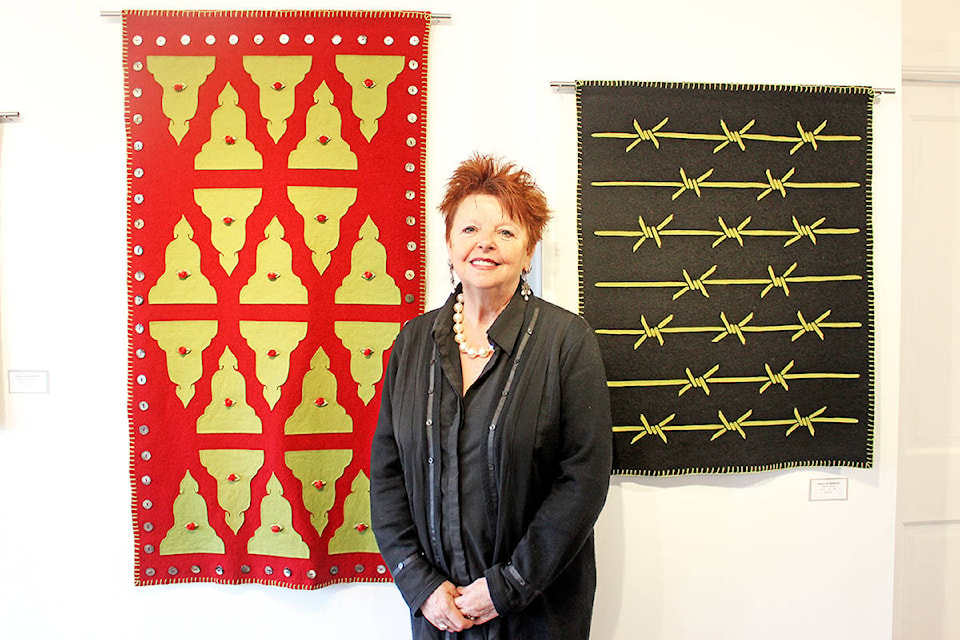Upstairs at the Station House Gallery presents a different scene than the intricate and geometric paintings in the main gallery.
Artist Valerie Arntzen’s “Ceremonial Blankets” exhibit is awash in rich colour, as bold patterns leap off of the fabric.
Religious iconography — the Buddha, the cross — sometimes separate, sometimes together, and those from fences — chainmail, barbed wire — stand out from the material in bright colours.
The stitching on the edges recall the ceremonial blankets of coastal First Nations.
Arntzen said, though she is not religious herself, that she has always been attracted to religious symbols, and often does a mashup, evident in the mixes of crosses and Buddhas in many of her pieces.
It first started as a young girl, when a close friend’s family ran a funeral home and Arntzen would attend many of the services. From there, she would visit many different churches, from Greek Orthodox to Catholic and sit in on services.
It also comes from travelling, she said.
“When I first started travelling I travelled on my own through Mexico and South America and I sat with the women on the bus and I got to talking and they introduced me to the Virgin of Guadeloupe, my very first saint. What I loved about that was the women had a hard life, especially then, with lots of kids and they worked hard and cooked, but they could go an sit in front of the Virgin and pray to her for anything.”
It’s an obsession that continues to this day.
“Wherever I go in the world I go to cemeteries and I go to churches — I just love the visuals.”
Still, there is something different in Arntzen’s work.
“Some of the Buddhas are upside down and the crosses are upside down. There is a bit of unease, so it makes you think. It’s the same with the fences: barbed wire, or chainmail. There is a bit of unease because it can stop or halt you, or contain you, but on the other side is safety as well, protecting you.”
While Arntzen is primarily an assemblage artist — putting art pieces together from a variety of found materials - this exhibit strays from her usual work.
She crafted most of the pieces while on a self-directed art residency in Amsterdam.
“When I got to Amsterdam, I realized I didn’t really have the tools or a studio, so I thought I would carry on with the fabric world, with textiles. So, I got on my bike, and in Amsterdam they have fantastic street markets and flea markets so I just started gathering materials.”
The mashup of colours, religious symbology, fence patterns, buttons and fabric flowers is evocative.
“I’m not so much a political artist, but I do think,” said Arntzen. “That’s where I love using things like real barbed wire — it’s sharp and so there is that sneaky bit of sharpness in my work.”
Religion, she said, despite the beautiful imagery that inspires her, also makes her sad.
“They can be so beautiful in the ceremonies and their stories, and then one of them doesn’t like the other,” she said. “And yet their religious are about protecting each other and then they fight.”
It’s there that the unease may show through, in the pieces that combine Buddhas and crosses, or show them just slightly out of place.
“I hope that things like this are kind of peaceful when you think about it; the crosses are right across from the Buddha, and then now they are together.”
Arntzen’s show is on display in the upstairs gallery of the Station House until the end of May.
